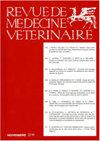Ventajas y desventajas del cultivo de carne in vitro: perspectivas desde la seguridad alimentaria
Q2 Veterinary
引用次数: 0
Abstract
espanolLos modelos tradicionales de produccion animal suponen un gran costo ambiental y economico. Tambien existen consideraciones eticas alrededor del bienestar animal con base en ciertos esquemas productivos. Estos aspectos, junto al hecho del incremento esperado en la demanda de proteina animal, paralelo al crecimiento poblacional para 2050, obligan a la industria carnica y al sector agropecuario a buscar tecnicas alternativas de produccion animal. La carne cultivada parece ser una opcion viable y plausible para resolver muchos de estos retos. El articulo aborda el tema de la ingenieria de tejidos, enfocado en las ventajas y desventajas de la produccion in vitro, como una posible linea de investigacion futura para paliar el hambre y la inseguridad alimentaria de forma ambientalmente sostenible. EnglishThe traditional models of animal production imply a great environmental and economic cost. There are also ethical considerations around animal welfare based on certain production schemes. These aspects, together with an expected increase in the demand for animal protein, parallel to population growth by 2050, have forced the meat industry and the agricultural sector to look for alternative techniques of animal production. Cultured meat seems to be a viable and plausible option to solve many of these challenges. The article addresses the issue of tissue engineering, focusing on the advantages and disadvantages of in vitro production, as a possible line for future research, to alleviate hunger and food insecurity in an environmentally sustainable manner. portuguesOs modelos tradicionais de producao animal supoem um grande custo ambiental e economico. Tambem existem consideracoes eticas em quanto ao bem-estar animal combase em certos esquemas produtivos. Estes aspectos, junto ao fato do incremento esperadona demanda de proteina animal, paralelo ao crescimento populacional para 2050,obrigam a industria de carnes e o setor agropecuario a buscar tecnicas alternativas deproducao animal. A carne cultivada parece ser uma opcao viavel e plausivel para resolvermuitos destes desafios. O artigo aborda o tema da engenharia de tecidos, com foco nasvantagens e desvantagens da producao in vitro, como uma possivel linha de pesquisa futurapara paliar a fome e a inseguridade alimentar de forma ambientalmente sustentavel.体外肉类培养的优缺点:来自食品安全的观点
传统的动物生产模式造成了巨大的环境和经济成本。在某些生产计划的基础上,也有关于动物福利的伦理考虑。这些方面,加上预计动物蛋白需求将增加的事实,与2050年人口增长平行,迫使肉类工业和农业部门寻求动物生产的替代技术。人工肉类似乎是解决这些挑战的可行和合理的选择。本文讨论了组织工程的主题,重点关注体外生产的优缺点,作为未来可能的研究路线,以环境可持续的方式缓解饥饿和粮食不安全。传统的动物生产模式造成了巨大的环境和经济成本。在某些生产计划的基础上,也有关于动物福利的伦理考虑。这些方面,加上预计到2050年人口增长,对动物蛋白的需求将会增加,迫使肉类工业和农业部门寻找动物生产的替代技术。文化肉类似乎是解决许多这些挑战的可行和合理的选择。这篇文章解决了组织工程的问题,重点关注体外生产的优缺点,作为未来研究的可能路线,以环境可持续的方式缓解饥饿和粮食不安全。葡萄牙传统的动物生产模式造成了巨大的环境和经济成本。在某些生产计划的基础上,也有关于动物福利的伦理考虑。这些方面,加上预计到2050年对动物蛋白的需求将随着人口增长而增加,迫使肉类工业和农业部门寻求动物生产的替代技术。人工肉类似乎是解决这些挑战的可行和可信的选择。这篇文章讨论了组织工程的主题,重点关注体外生产的优缺点,作为未来可能的研究路线,以环境可持续的方式缓解饥饿和粮食不安全。
本文章由计算机程序翻译,如有差异,请以英文原文为准。
求助全文
约1分钟内获得全文
求助全文
来源期刊

Revue De Medecine Veterinaire
农林科学-兽医学
CiteScore
1.30
自引率
0.00%
发文量
0
审稿时长
18-36 weeks
期刊介绍:
The Revue de Médecine Vétérinaire publishes four kinds of text:
1) Scientific reviews on subjects related to veterinary and comparative medicine. Suggested length: 10 to 30 typed pages.
2) Original reports on fundamental or applied research. Suggested length: 10 to 15 typed pages.
3) Continuous education articles, that should be easily understandable by non-specialists. Suggested length: 10 to 15 typed pages.
4) Clinical reports. Suggested length: 5 to 15 typed pages.
The publication can be done in French language or English language.
For an article written in English by not english native speakers authors, the manuscript must be subjected by attesting that it was read again by an anglophone scientist or a scientific translator.
The authors must certify that the manuscript was not published or subjected for publication to another review.
The manuscript must be accompanied by a sheet signed by all the joint authors indicating their agreement for the tender of the manuscript.
The publication is free but a financial participation could be required for the photographs color. An estimate will be sent to collect the agreement of the authors.
 求助内容:
求助内容: 应助结果提醒方式:
应助结果提醒方式:


